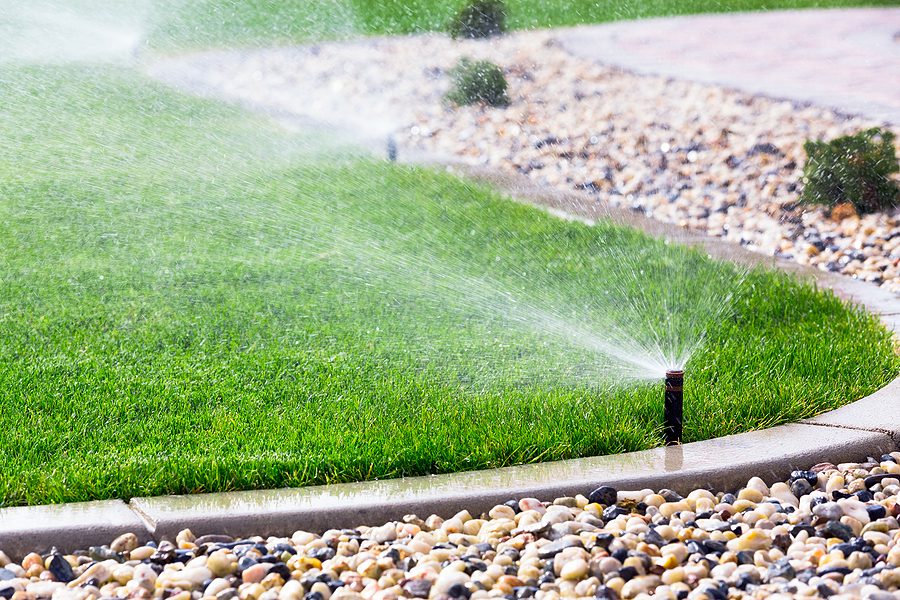How Do You Do DIY Spring Sprinkler Start Up?

You really might not have to pay a local landscaping company a small fortune every spring to turn on your sprinkler system.
If you’re up to getting your hands dirty, we’ll take you through all the steps you need to get that water flowing.
If you find it too difficult you can always book sprinkler system turn-on services from a local landscaping company.
Review Your System First
Before we start opening valves and turning handles, it’s wise to piddle around a little and feel out the landscape. After months of bitter cold, floods, snow piles and God knows what else, you’ll want to see if any of your equipment sustained damage.
Imagine a stroll around your pipes, valves, and sprinkler heads — you get the drift.
If you notice any cracked fittings, bent pipes or broken sprinklers, jot down a note where you can find the repairs before the water starts gushing. Safety first!
Gather the Essential Gear
You might already have some of this stuff in the garage or tool box:
- Screwdriver – flathead and/or Phillips head
- Pliers – make sure they’re not too rusty!
- Sprinkler valve key – usually a little T-shaped gadget, super helpful for getting into valve boxes
- Notepad and pen – for jotting down damage, making notes as you go
And there’s no shame if you need to make a run to the hardware store for materials. Now you have an excuse to wander the aisles and grab one of those hot dogs spinning seductively on the roller grill at the register.
Know How the System Works
Before we start flipping switches and cranking handles, however, you need to know how all this stuff actually works. Every system is slightly different, but here’s a sense of what you might find:
The Main Shutoff Valve: This dude controls water flow to the whole sprinkler system. It’s often located near the house foundation and may resemble a spigot handle or round valve wheel.
The Vacuum Breaker: Generally located higher up on the wall/pipe than the main valve. Prevents “backflow” issues. Also has an inlet pipe, outlet pipe, and possibly test ports.
Control Panel: Options for outside, garage, or basement mounting. Includes buttons/switches/display for programming your sprinklers
Sprinkler Heads: Attached along pipes/tubing in lawn and beds. Small caps unscrew while in operation.
How to Turn a Sprinkler System on in Spring
Follow these steps for the best chance for your grass and gardens to thrive all through the growing season.
#1 Make Sure That Main Valve is Closed
Before you do anything with the valves or pipes, you will first want to find the main shut-off valve that allows the water to enter into the sprinkler system. This is typically located in your basement, crawlspace or within an outside wall of your home where the water line enters underground. You are looking for a pipe poking through the wall or floor with a valve on it — usually with a blue handle.
This valve should be in the closed position and the handle should sit at right angles to the pipe. If it’s a round, hose bib-type gate valve, it should be all the way clockwise. In the case of a lever-style butterfly valve, the handle must be perpendicular to the valve opening.
By closing this main valve, you stop the flow of water through the entire system while you work to restore it. Think about that power switch that puts everything into the OFF position until you are ready to turn-on each element.
#2 Turn the System on Manual Mode First
Proceed to the control panel for your sprinkler system, which is usually found in a garage, basement utility room or outside access point. Here is a display with buttons or switches for programming the automated settings that control when each watering zone is activated on a schedule.
When you can, find a switch or button and put the panel in MANUAL.
This removes the preprogrammed timer element, so watering doesn’t activate automatically as you’re testing and adjusting the system. MANUAL mode lets you bring one zone active at a time to monitor performance, before allowing automation to take the reins again.
That gives you almost surgical control bringing the system back online from its winter nap.
#3 Tighten the Screws on the Vacuum Breaker
Now go outside at or near the spot where the main water line enters the home to find the vacuum breaker device. This device is placed in the pipe between the control valve and the other system pipes which are extending underground.
Your mission is to make sure that water drawn from your lawn’s pipes never backs its way into your home’s supply of drinking water. It features a pair of large valve handles used to close off the outflow of the water, along with two smaller bleeder valves.
Those bleeders let off excess pressure to prevent pipes from bursting. Make sure there is no accidental run loss by ensuring that the screw knobs on the bleeder valves are closed very tightly. During winter, when the system remains frozen, they are partially opened to allow moisture that has become trapped to escape, preventing ice from forming and splitting the valve housing.
But now that the system is on for spring, any drips or leaks are caught at this point. Twist each bleeder screw a few extra times with a flat screwdriver to help ensure they are sealed tight.
#4 Turn the Big Valves on the Vacuum Breaker
There will be one or two larger valves, which control the passing of liquid water through the red metal device up to the vacuum breaker. Look at the handles of the ball valve here — probably a quarter-turn, meaning you turn the handle 90 degrees to open it, or a butterfly design that takes the handle down parallel with the pipe to show flow is enabled.
With bleeders now closed, this is time to adjust these main valves so that their handles align with the pipe — allowing water to flow through the vacuum breaker. Opening these 2 large valves paves the way for pressurizing the system
#5 Cap the Bleeder Valves
In fact, take a closer look at those small bleeder valves on the side or top ends of the vacuum breaker. You’ll probably encounter threaded fittings where protective caps screw in at the openings of their outlets to prevent dirt and debris from getting into the works while still allowing pressure releases as needed.
During winter, the caps come off — now return them. Simply spin each cap down tightly by hand or with pliers over the valve fittings. Just don’t overtighten them or you’ll break the plastic caps. The malleable pressure exerted by hand-tightening is sufficient to protect the bleeders.
#6 Open the Main Valve Slowly to Fill the System
A network of sprinklers awaits, at the ready, to carry out your command. Now walk back over to that main water supply valve you were at the beginning — probably attached to the wall near your home’s foundation, where underground pipes come aboveground — and place your hand on its handle.
Slowly and carefully, start to open the valve counter-clockwise so water can make its way into the long-slumbering system. Go slowly! Cranking the valve wide open can send high-pressure water hammering through the pipes, damaging valves or launching sprinkler heads aloft like a rocket on a launchpad.
Ease it open to about a quarter capacity for 30 to 60 seconds, then half for the same amount of time, listening closely for any errant hisses or drips. If nothing happens, keep opening the valve until it’s fully counterclockwise and parallel with the pipe. Congratulations, your sprinkler system now comes to life with water flowing through its veins! But our work is not finished yet…onward!
#7 Check the Valves & Vacuum Breaker
But before you start pushing buttons on that control panel, walk those network of pipes springing out of your house searching for leaks or fittings loosened by winter frosts and thaws. Trace the main line toward your garden beds and turf zones, mapping visually branches to each sprinkler head or drip emitter endpoint. Cover cracks or fasten hose fittings that don’t seem snug with gaskets. Make sure buried pipes haven’t been exposed and made vulnerable.
Swing back past the vacuum breaker valve to check that everything in that area is still sealed tight, no drips or hisses as water passes through. A few drops from those bleeders on first pressurization is no problem. But repetitive leaking means screws need to be closely re-closed. When it finds its way into a pipe joint or around valve handles, there should never be any moisture. Water-safe networks that are tight are right.
#8 Test Each of the Zones Individually
The next thing is to walk through the area and watch and listen for that first group of sprinkler heads to start squirting. Keep your eagle eye out for misaligned nozzles spraying stray patterns instead of evenly watering plantings.
Also, check for patches of grass or garden drying out when they should be soaking wet for a lack of liquid. It is a suggestion of underground tubes torn asunder. Use your phone or a clipboard to make notes, sketching zone numbers to any area that may need some adjustment.
When the inspection is done close the panel and disable zone 1. Repeat for the remaining zones, making sure all heads pop on and spew out water precisely where parched roots want their share.
#9 Activate Scheduled Watering
When all zones have passed muster, return that MANUAL override switch to AUTO mode and let the scheduled calendar take over.
Now, your lawn knows exactly when to drink up! But before walking away, push those scheduling buttons to ensure you have cycles suited to the needs of the new growing season.
With possible landscape additions or evictions through winter, take fresh stock of sunlight patterns that determine soil moisture and plant needs in microclimate zones of your yard.
Maybe eliminating a shade tree means more sun-fueled power for a former problem dry spot or expanded pavement increases runoff, so less water is now sufficient for adjacent beds.
Adjust your timing and frequencies across your irrigated acreage. Set it…and forget it!
Well, at least until those autumn shutdown steps roll around again in 6 months or so when the ground again goes frigid.
But for now, allow your polished sprinkler system to do its thing so your landscape thrives as a genuine backyard oasis. Welcome spring!
